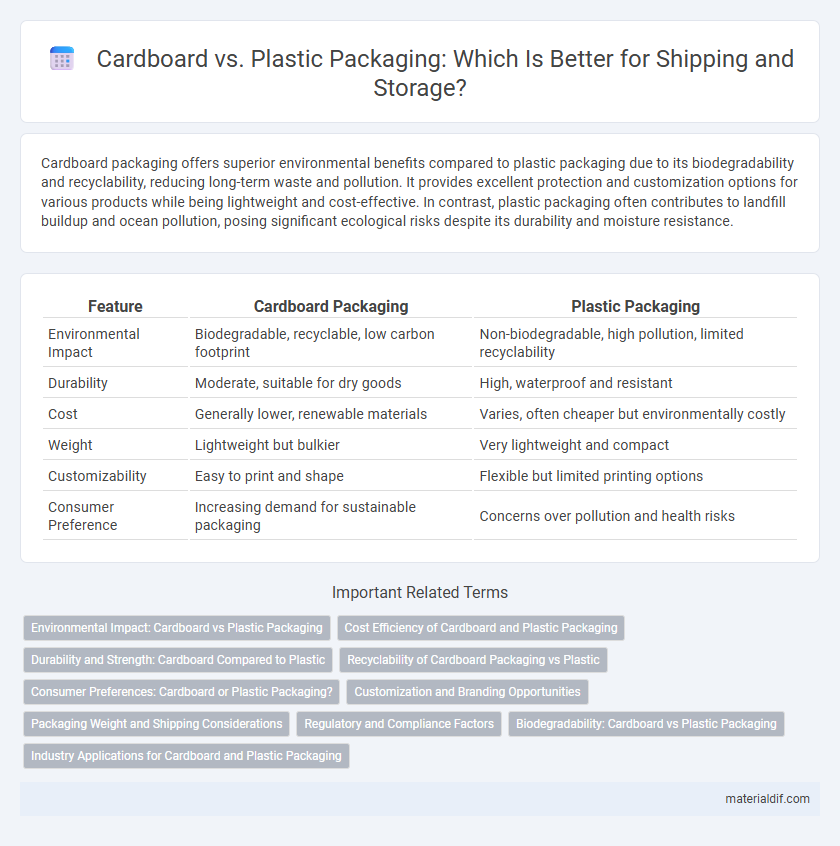Cardboard packaging offers superior environmental benefits compared to plastic packaging due to its biodegradability and recyclability, reducing long-term waste and pollution. It provides excellent protection and customization options for various products while being lightweight and cost-effective. In contrast, plastic packaging often contributes to landfill buildup and ocean pollution, posing significant ecological risks despite its durability and moisture resistance.
Table of Comparison
| Feature | Cardboard Packaging | Plastic Packaging |
|---|---|---|
| Environmental Impact | Biodegradable, recyclable, low carbon footprint | Non-biodegradable, high pollution, limited recyclability |
| Durability | Moderate, suitable for dry goods | High, waterproof and resistant |
| Cost | Generally lower, renewable materials | Varies, often cheaper but environmentally costly |
| Weight | Lightweight but bulkier | Very lightweight and compact |
| Customizability | Easy to print and shape | Flexible but limited printing options |
| Consumer Preference | Increasing demand for sustainable packaging | Concerns over pollution and health risks |
Environmental Impact: Cardboard vs Plastic Packaging
Cardboard packaging significantly reduces environmental impact due to its biodegradability and high recyclability compared to plastic, which often persists in ecosystems for centuries. The production of cardboard generally consumes less energy and results in lower greenhouse gas emissions than plastic manufacturing. Moreover, cardboard's ability to break down naturally minimizes landfill accumulation, whereas plastic packaging contributes to long-term pollution and microplastic contamination.
Cost Efficiency of Cardboard and Plastic Packaging
Cardboard packaging offers superior cost efficiency due to lower raw material costs and ease of recycling, reducing overall expenses in supply chains. Plastic packaging often incurs higher production and disposal costs, negatively impacting long-term budget efficiency. Companies choosing cardboard benefit from decreased waste management fees and increased sustainability incentives that further enhance cost savings.
Durability and Strength: Cardboard Compared to Plastic
Cardboard packaging offers competitive durability and strength, especially when engineered with multiple layers or corrugation, making it suitable for protecting a wide range of products during shipping and handling. Unlike plastic packaging, cardboard is more prone to moisture damage but excels in rigidity and impact resistance under dry conditions, supporting heavier loads without deformation. Advances in water-resistant coatings and reinforced designs are narrowing the gap, allowing cardboard to rival plastic's durability while maintaining its eco-friendly advantages.
Recyclability of Cardboard Packaging vs Plastic
Cardboard packaging offers superior recyclability compared to plastic packaging, as it can be easily processed through standard paper recycling systems and biodegrades relatively quickly if discarded. Plastic packaging often requires specialized recycling facilities and can take hundreds of years to break down, contributing significantly to environmental pollution. The widespread recyclability and compostability of cardboard make it a more sustainable choice for reducing landfill waste and conserving natural resources.
Consumer Preferences: Cardboard or Plastic Packaging?
Consumers increasingly prefer cardboard packaging over plastic due to its eco-friendly nature and recyclability, aligning with rising environmental awareness. Studies reveal that 70% of shoppers favor cardboard because it is biodegradable and perceived as safer for food products. Plastic packaging, while durable and lightweight, often faces criticism for contributing to pollution, leading many consumers to shift their loyalty towards sustainable alternatives like cardboard.
Customization and Branding Opportunities
Cardboard packaging offers superior customization options compared to plastic, allowing brands to easily incorporate unique shapes, colors, and printed graphics that enhance brand visibility. Its versatility enables tailored designs that align with specific product needs and marketing strategies, strengthening brand identity. Unlike plastic, cardboard supports eco-friendly messaging, appealing to environmentally conscious consumers and reinforcing sustainable branding initiatives.
Packaging Weight and Shipping Considerations
Cardboard packaging generally weighs less than plastic packaging, reducing overall shipment weight and lowering freight costs. This lighter weight allows for more efficient space utilization in shipping containers, increasing the number of units per load. Additionally, cardboard's rigidity protects products effectively during transit, minimizing damage and returns.
Regulatory and Compliance Factors
Cardboard packaging aligns with increasing global regulatory demands for sustainable materials, meeting standards such as the EU's Single-Use Plastics Directive and the U.S. EPA's emphasis on recyclable content. Plastic packaging faces tightening restrictions due to environmental concerns, prompting compliance with bans on single-use plastics in over 60 countries and extended producer responsibility (EPR) regulations. Adopting cardboard reduces legal risks and supports compliance with evolving policies targeting waste reduction and carbon footprint mitigation.
Biodegradability: Cardboard vs Plastic Packaging
Cardboard packaging offers significantly higher biodegradability compared to plastic packaging, breaking down naturally within months under composting conditions. In contrast, plastic packaging can persist in the environment for hundreds of years, contributing to pollution and landfill overcapacity. The organic composition of cardboard enables efficient recycling and soil integration, reducing ecological impact.
Industry Applications for Cardboard and Plastic Packaging
Cardboard packaging dominates industries such as food and beverage, electronics, and e-commerce due to its sustainability, recyclability, and protective cushioning properties. Plastic packaging remains prevalent in pharmaceuticals, cosmetics, and refrigerated goods for its moisture resistance and durability. Industry applications increasingly favor cardboard for eco-friendly branding and regulatory compliance, while plastic packaging is chosen for functional performance in moisture-sensitive products.
Cardboard packaging vs Plastic packaging Infographic

 materialdif.com
materialdif.com